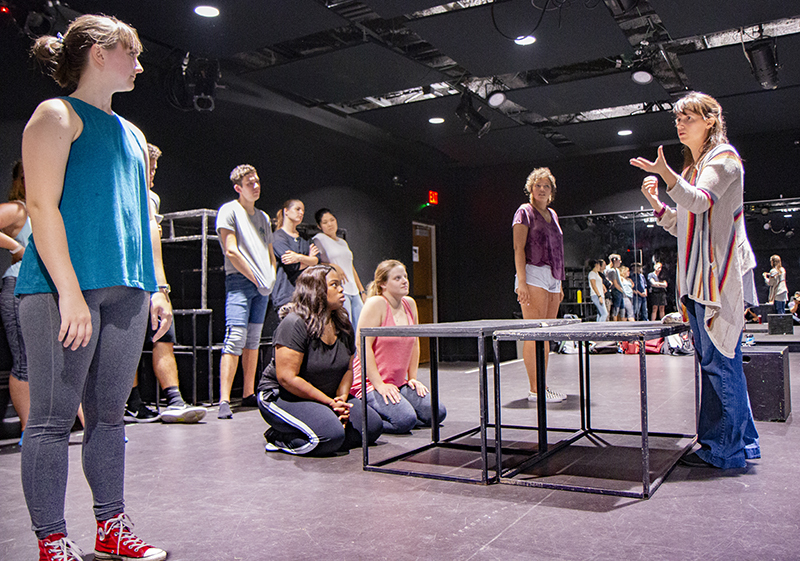Determining how to legally use copyrighted materials in teaching often yields an unsatisfying answer: It depends.
"It kind of comes down to reading the fine print," said Barbara Biederman, associate counsel in the office of university counsel. "Copyright is a very fact-specific kind of matter."
To help navigate copyright issues in the classroom, Biederman and Abbey Elder, open access and scholarly communication librarian, held a hands-on workshop earlier this month. Here are some tips culled from their workshop, a quick guide they provided participants and online resources recommended by the library.
Link when you can
When sharing readings or other copyrighted content without permission, the safest move is providing an online link to an original source or the library. That avoids infringing on a creator's rights to determine how their work is used, reproduced, distributed, adapted or displayed.
"Linking is always the best practice," Biederman said.
Even for journals the library subscribes to, providing students a link is better than a printed copy or an uploaded PDF because it gives the library, and the copyright holders, more accurate usage data, Elder said.
What about classroom use?
Copyright law includes an exemption for classroom use, which allows for displaying or performing copyrighted work but not distributing or reproducing it. The material must be presented in a classroom setting for face-to-face instruction at a nonprofit institution.
The federal TEACH Act provides similar protection for displaying or performing copyrighted work in online courses but with far more strings attached. For instance, content can't be designed for online educational use and must be presented in a time-limited format designed to prevent students from downloading it.
For online courses, it's often easier to use a fair-use exemption than the TEACH Act, Elder said.
Fair use
There are no simple rules to follow in deciding whether sharing copyrighted material without permission qualifies under the wide-ranging and essential exception to copyright law known as "fair use." Claiming a fair-use exemption requires balancing four factors, a subjective endeavor that's spurred mountains of court cases.
"They're all weighted equally. You have to do a holistic evaluation of that," Biederman said.
The factors to consider:
- Purpose and nature of use If you're using the content for teaching, research, scholarship, journalism or criticism, or to transform it into something new, that favors fair use. Commercial uses count against.
- Nature of original Work that's published is more likely to be fair use than unpublished work. Nonfiction weighs on the fair use side, creative work weighs against.
- Amount of original used Using less of an original, an appropriate amount for the educational purpose, makes it more likely to be fair use. Using the entire work isn't allowed.
- Effect on original If the use would deprive the copyright holder of income, that's a strike against fair use.
Create and retain a written record of your analysis, and consider consulting with colleagues or the experts in the university counsel's office or library. Keep in mind that using material for an educational purpose doesn't on its own qualify as a fair use.
No worries
Copyright concerns can be avoided, of course, by getting permission to use copyrighted work. The permission should be in writing and explicit about the uses granted and for how long.
In addition, work that is in the public domain can be used and shared freely by anyone. That includes ideas and facts, government documents, work published prior to 1923 or by a creator dead for at least 70 years, and material assigned the Creative Commons license CC-0. (Other Creative Commons licenses may allow for more limited uses, as well.)
However, be careful in assuming material is public domain because it is labeled that way online. The designation could be incorrect.
"You need to question where your sources are coming from," Elder said.
There's help
Copyright holders can and do seek out potentially improper uses to demand royalties they believe they're due, Biederman said.
"Unfortunately, or fortunately, the more you learn about copyright, the less comfortable you might feel in the decisions you're making," she said.
But Iowa State employees aren't personally at risk if they're not negligent or violating the law intentionally, Biederman said.
"As long as you're using due diligence, I wouldn't let that paralyze you as much as it probably seems like it should," she said.
Elder and Biederman encouraged anyone struggling with a copyright question to ask them for help.
"We're not going to just tell you, 'No, that's illegal.' We're going to help you work through how to actually use something," Elder said.
Elder can be reached at 294-5753 or aelder@iastate.edu. Biederman can be reached at 294-0147 or barbara@iastate.edu.

